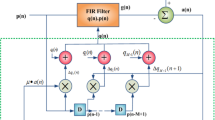Abstract
An efficient way for computing the response of an adaptive digital filter is to use sliding-block distributed arithmetic (SBDA). However, a disadvantage of distributed arithmetic is the amount of memory utilized. By encoding the memory tables in offset binary code (OBC), the size of the memory tables is reduced by half, while the computational workload remains unchanged. By modifying the computational flow, the computational workload can be reduced by almost by half at the expense of slightly more memory. This modified SBDA structure is called SBDA-OBC. It has memory requirements 25–50% lower than SBDA depending on the size of the sub-filter. In terms of the computational workload, SBDA-OBC is most advantageous for large sub-filters and when the filter is split into few sub-filters. In this case, the computational workload is reduced almost in half.










Similar content being viewed by others
References
Jones, D. L. (1993). Efficient computation of time-varying and adaptive filters. IEEE Transactions on Signal Processing, 41, 1077–1086.
Hwang, K. (1979). Computer arithmetic: Principles, architecture, and design (1st ed.). New York: Wiley.
Peled, A., & Liu, B. (1974). A new hardware realization of digital filters. IEEE Transactions on Acoustics, Speech, and Signal Processing, 22, 456–462.
White, S. A. (1989). Applications of distributed arithmetic to digital signal processing: A tutorial review. IEEE ASSP Magazine, 6, 4–19.
Cowan, C. F. N., & Mavor, J. (1981). New digital adaptive-filter implementation using distributed-arithmetic techniques. IEE Proceedings, Part F: Communications, Radar and Signal Processing, 128, 225–230.
Cowan, C. F. N., Smith, S. G., & Elliott, J. H. (1983). A digital adaptive filter using a memory-accumulator architecture: Theory and realization. IEEE Transactions on Acoustics, Speech, and Signal Processing, 31, 541–549.
Wei, C. H., & Lou, J. J. (1986). Multimemory block structure for implementing a digital adaptive filter using distributed arithmetic. IEE Proceedings, Part G: Electronic Circuits and Systems, 133, 19–26.
Allred, D. J., Yoo, H., Krishnan, V., Huang, W., & Anderson, D. V. (2005). LMS adaptive filters using distributed arithmetic for high throughput. IEEE Transactions on Circuits and Systems, 52(7), 1327–1337.
Author information
Authors and Affiliations
Corresponding author
Rights and permissions
About this article
Cite this article
Huang, W., Anderson, D.V. Modified Sliding-Block Distributed Arithmetic with Offset Binary Coding for Adaptive Filters. J Sign Process Syst 63, 153–163 (2011). https://doi.org/10.1007/s11265-010-0479-4
Received:
Revised:
Accepted:
Published:
Issue Date:
DOI: https://doi.org/10.1007/s11265-010-0479-4




